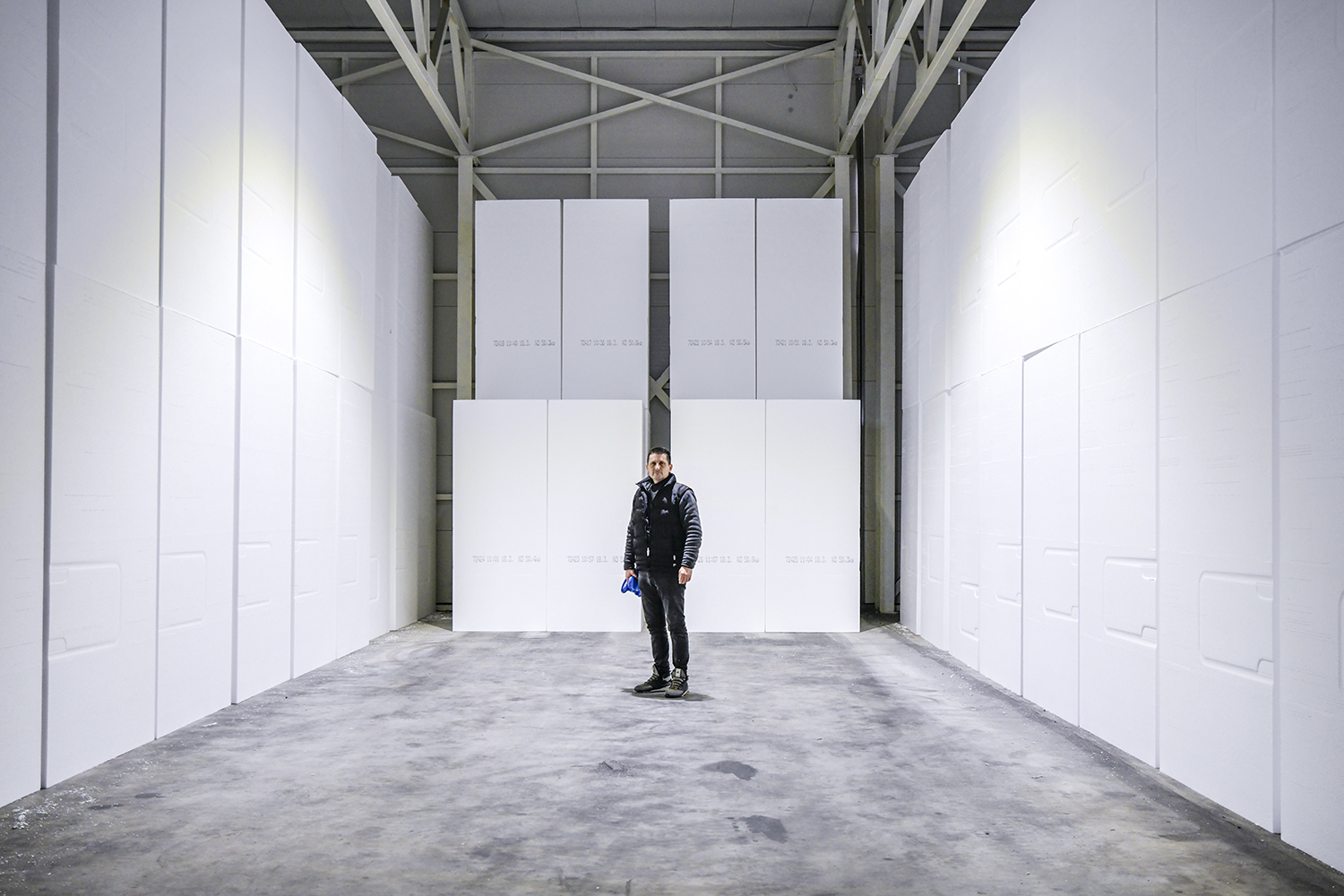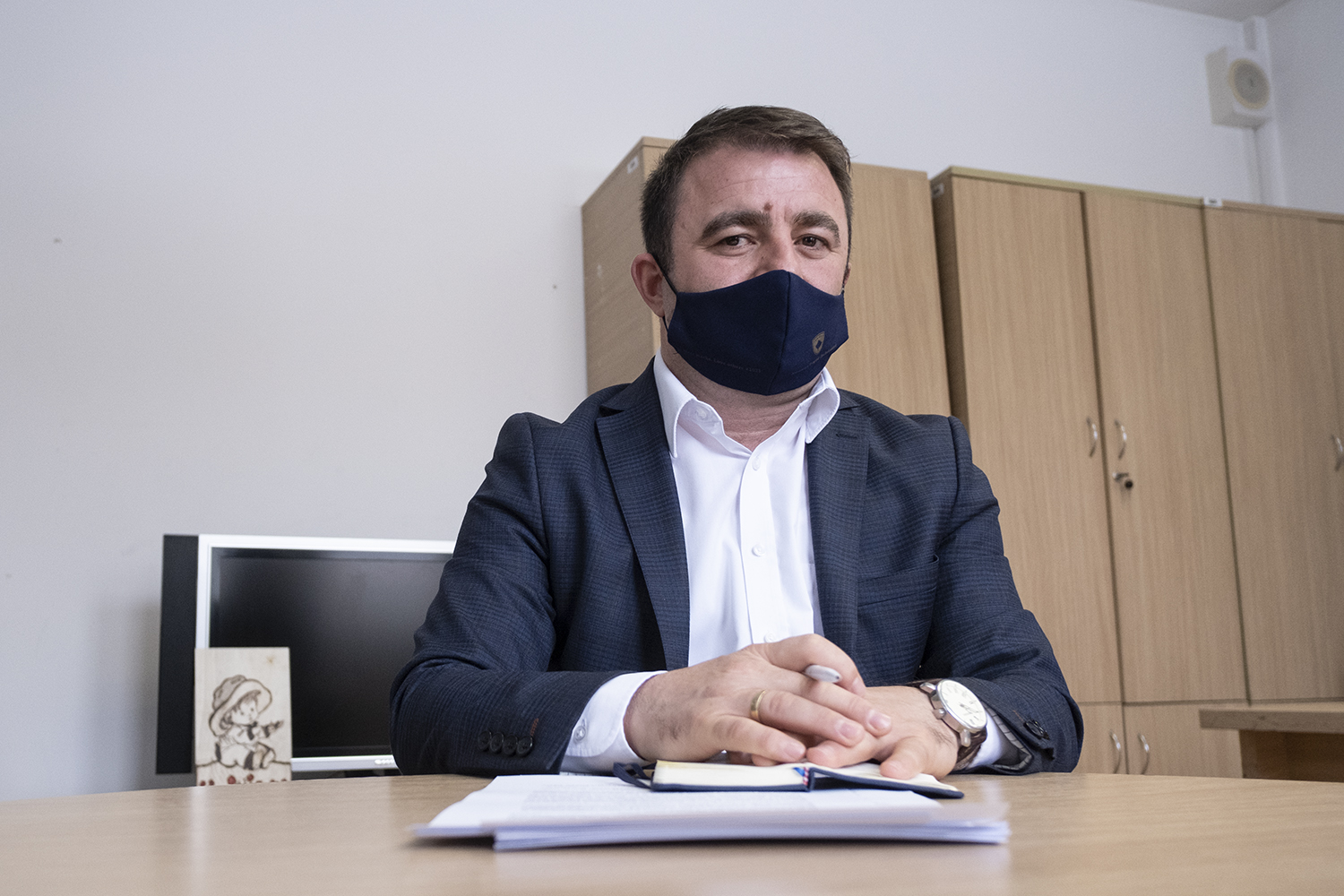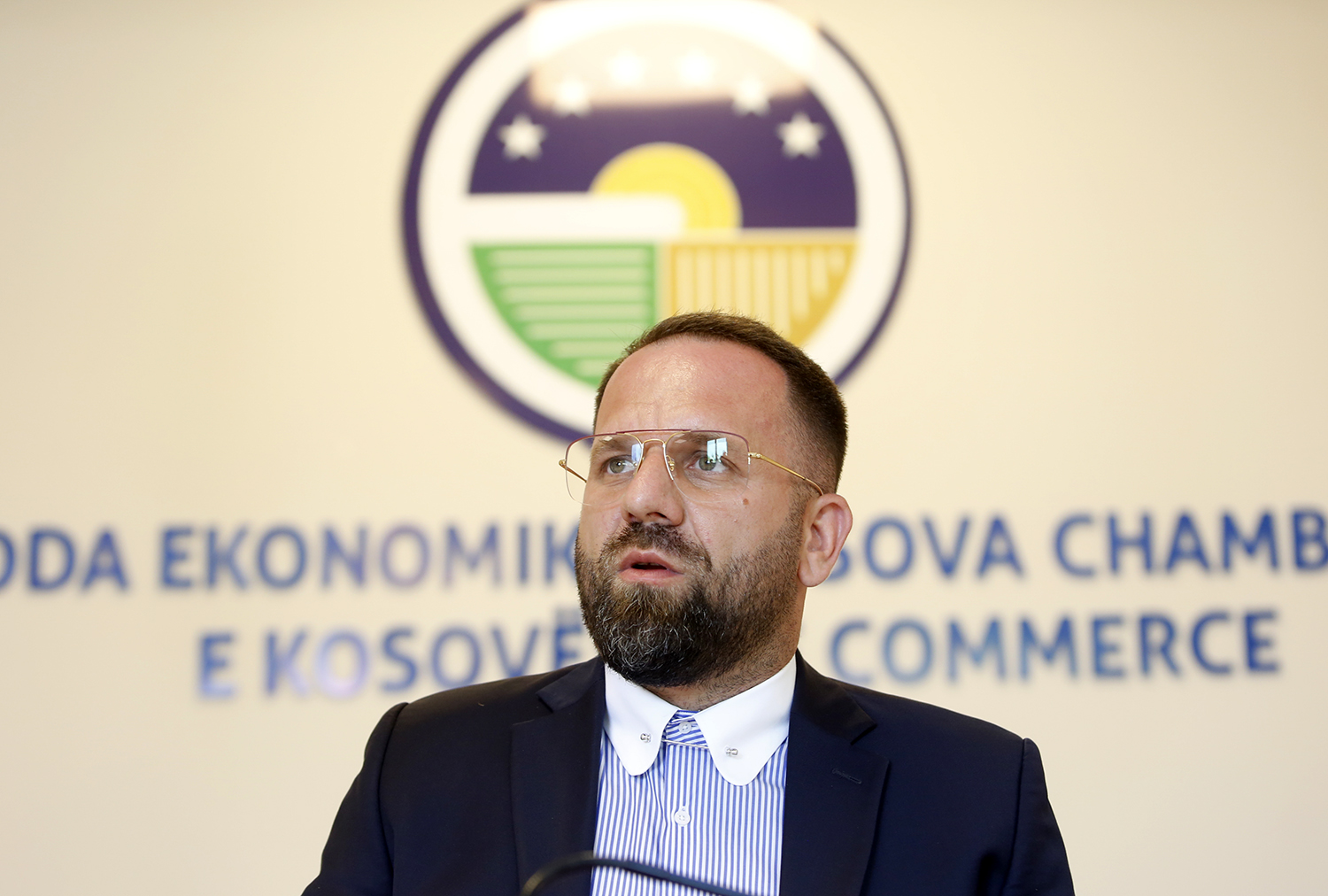Jeton Shabani seems to grow 5 centimeters taller as he shows K2.0 around the factory floor of his business.
Passing by piles of large white blocks, he stops opposite the entrance at the point where the production line begins. By the way in which he explains the machinery work, routinely and yet with plenty of energy, it is clear that he has done this kind of tour many times before. The well-rehearsed role performed in a familiar setting for him, coupled with the loud noise all around, leaves little space for spontaneous questions; the script has to be followed until the end.
Jeton and his brothers own the Bunjamini company — a private enterprise that produces a variety of rendering and plastering materials. Having been in business since 1992, in 2017 they thought it was about time to grow their company by opening a polystyrene foam factory, in addition to their two other sites producing mainly adhesives and paints.
“With a loan we received and the capital we already had, we managed to invest more than 3 million euros here. The infrastructure was not completed, but what mattered most to us was the land,” Jeton explains once outside the factory. “The rent we pay here is almost infinitesimal; that’s what makes the location beneficial for us.”

Jeton Shabani and his brothers expanded their Bunjamini company in 2017 by opening a polystyrene production factory in the Industrial Park in Frashër, close to Mitrovica. Photo: Atdhe Mulla / K2.0.
The land on which they decided to build the factory, in Frashër village about 5 kilometers outside of Mitrovica, is part of a 48 ha Industrial Park, an economic zone created in 2014 with the aim of offering space and basic infrastructure to growing businesses.
The Park lists 20 other businesses registered to use the area for developing their economic activities. However, since the establishment of the economic zone in 2014, with the exception of Bunjamini — which employs 10 people at the site out of over 70 employees in total — no business has begun operating there. As a result, the zone looks far from the vibrant economic area that could have helped bring Mitrovica back the lost epithet of the “industrial city.”
Meanwhile in the city’s Business Park a few kilometers up the road from Frashër, the Municipality of Mitrovica says it is reviewing the contracts of a number of businesses that have illicitly sublet the business premises that they have been provided with for free.
In total, there are 10 economic zone sites across the country that operate under different names — Business Park, Technologic Park, Agro-industrial Zone or Industrial Park — and all created over the past decade. However, not all of them are operational.

According to the Municipality of Mitrovica, many of the private enterprises contracted to operate from the Business Park in Mitrovica have sublet the premises that they receive for free. Photo: Atdhe Mulla / K2.0.
Since 2010, when the first business park was established in Drenas, the project of economic zones has altered from an initiative promising to support the private sector, attract foreign investments and generate economic growth to a space of political confrontations and criticism of electoral and party interests, mismanagement, and lack of creative solutions.
Despite the continued promises about their potential — at least 11 current mayors pledged to build new economic zones in the last mayoral elections four years ago — there has been no detailed analysis of the economic benefits of economic zones.
Last year, the Ministry of Trade and Industry (MIT) initiated the process of amending the Law on Economic Zones, breathing fresh impetus into debates around their impact and functionality.
The thinking behind economic zones
The concept of an economic zone is not new. Indeed, historians have discovered evidence of an ancient “free zone” on Delos in 166 B.C., a decision that catapulted the Greek island to become one of the wealthiest islands worldwide for nearly a century.
The modern-day version of the economic zone is based on the same principle: providing advantageous business conditions in certain locations to encourage the economic development of a place. A well-developed infrastructure, low cost rents, administrative services, easier access to transport and connections, staff training centers, enhanced business cooperation, combined sometimes with fiscal incentives such as tax holidays, are some of the benefits that are intended to make economic zones attractive to businesses.
As per current legislation, economic zones in Kosovo are established by the government based on an MIT proposal. Such a proposal is only submitted after municipalities or business organizations that are interested in establishing an economic zone submit a written request to Kosovo Investment and Enterprise Support Agency (KIESA) — the body within the MIT responsible for managing economic zones. However uncertainties over legal competencies and practical difficulties in establishing economic zones are just some of the issues that amendments to the law are intended to address.
Within the economic context of Kosovo, the need for well-functioning economic solutions is clear.
With the highest unemployment rate in the region and a trade deficit up to 30% of GDP, Kosovo’s slow economic growth during the last decade has not managed to address structural problems and generate development in the country. Women continue to be hugely underrepresented in the labor force with an employment rate of just 13.7%, while remittances — transfers of money into the country from the diaspora — succor the consumption capacity of households.
According to the Kosovo Agency of Statistics, the overall unemployment rate remains almost 25% — a stark reminder of the persistent challenges that the pandemic has only added to for businesses and workers over the past 12 months. Such a sentiment was reinforced by the IMF, who in February projected that Kosovo’s projected economic growth will “remain below the pre-crisis trend for a protracted period.”
The current situation reinscribes the need to support Kosovo’s productive industries and attract foreign investment from the diaspora or other foreign investors.
Proponents of economic zones argue that they can offer the opportunity for the diaspora to re-orientate some of their remittances from households into export-focused and heavily job-creating industries. These aspects are also reflected in the Law on Economic Zones that defines the main purpose of establishing economic zones as “helping the overall economic development in Kosovo, [the] private sector in particular.”
Weighing up the costs and benefits
The idea of creating economic zones in Kosovo was initiated in the first half of the 2000s when a pilot project was introduced in the municipalities of Drenas and Mitrovica.
In 2010, one year after the adoption of the first Law on Economic Zones, the Business Park in Drenas would become the first economic zone formally established in the country. Now, covering 24 ha and with 41 businesses operating there, the park is one of the most populated economic zones in the country.
According to KIESA, the Business Park in Drenas, the Technologic Park in Shtime, and the Business Park in Mitrovica are the three zones where the infrastructure has been fully completed.
But in four others, located in Shirokë (Suhareka), Viti, Lipjan, and Vushtrri, there are still different infrastructural aspects to be finalized, while the investments in the zones in Suhareka, Frashër (Mitrovica) and Rahovec have been much slower.
Director of KIESA’s Private Sector Development Directorate, Nol Buzhala, says that “if things go as planned” they are going to finalize the infrastructure of the zones in Shirokë, Viti and Vushtrri this year. However, he says developing the remaining zones will take much longer and points to a lack of budget as the main cause of delays.
“With around 1.2 million euros of annual budget the Ministry has for capital investments, infrastructure finalization takes up to three or four years,” Buzhala says. “Based on an estimation, we would need 15 million euros to complete all the zones.”

Nol Buzhala, head of KIESA’s Private Sector Development Directorate, believes that Kosovo’s economic zones represent a rare economic success story in the post-independence era. Photo: Atdhe Mulla / K2.0.
According to data provided to K2.0 by KIESA — which differs from data on its website — Kosovo’s economic zones currently house around 130 businesses and between 1,600 and 2,000 employees, depending on the season.
Buzhala is quick to assess that these figures represent “one of the few tangible economic developments” in post-independence Kosovo. “It’s a success story — where before were barren lands, now there are production areas.”
Such optimism is countered by Mimoza Kusari Lila, leader of the Alternativa party, who was reelected as an MP as part of Vetëvendosje’s list in February’s extraordinary general election. As a former Minister of Trade and Industry between 2011 and 2013, and then mayor of Gjakova, she was directly involved in the efforts to materialize the concept of economic zones.
Now, she does not hold back when assessing how the whole process has turned out.
“There are two main failures that have accompanied economic zones in all the governments until now — politicization and mismanagement,” she says. “There was mismanagement in procurement procedures as well as the implementation and supervision of the projects. This reflects the broader problem with the rule of law in Kosovo.”

Mimoza Kusari Lila was actively involved in trying to develop an economic zone in Gjakova when she was mayor of the city but says her efforts were hampered by mismanagement and politicization. Photo: Atdhe Mulla / K2.0.
For Kusari Lila, the lack of budget is not a valid justification for what she deems as “a minimal success of economic zones” in creating new jobs and economic development in the country. “More than insufficient budget, there has been a lack of creative solutions, proper planning and accountability. If there had been innovative projects and political will, more donor funding could have been attracted,” she says.
Berat Rukiqi, president of the Kosovo Chamber of Commerce, also agrees that economic zones have not managed to provide substantial support to the private sector. “Except the land and basic infrastructure, currently economic zones in Kosovo do not offer other benefits for the businesses,” he says.
Rukiqi adds that Kosovo should consider the sectorialization of economic zones as a way of encouraging specific sectoral capacities in certain regions of the country. Successful examples of economic zones in the region, such as in Turkey and neighboring North Macedonia “have combined administrative and professional services that simplify bureaucratic procedures with fiscal incentives,” Rukiqi says.

Berat Rukiqi, head of the Kosovo Chamber of Commerce, says the operation of economic zones can be improved by learning from regional examples. Photo: Atdhe Mulla / K2.0.
It was with this mentality that the process of establishing the first “free” economic zones, in Mitrovica and Gjakova, was initiated in 2014. Free economic zones are generally intended to go further in the potential benefits they offer businesses, with the state creating fiscal benefits such as exemption from the payment of customs duties or value added tax, in addition to the regular infrastructural benefits of an economic zone.
A feasibility study assessed that the municipalities of Gjakova — in the south, near the border with Albania — and Mitrovica — in the north, near the border with Serbia — had the conditions and the potential to establish free economic zones. Both of the municipalities were highly industrialized during the time of Yugoslavia, had an industrial labor force and both are considered to be in advantageous locations for cross-border trade.
“In the last moment, the government, then led by the PDK-ARK coalition, also included Prizren in the project of free economic zones, even though there was no economic analysis for this municipality,” says Kusari Lila, adding that this was done mainly for electoral interests.
A report on Kosovo’s economic zones recently published by GAP Institute echoes such sentiments, assessing that the process of creating the free economic zones “was governed by the main parties in the ruling coalition, and the decisions were more for electoral purposes than based on an economic justification.”
It also points to a 2017 government-approved concept paper that found there was a lack of a concrete definition as to what is meant by the term “free” economic zone.
To date, none of the declared free economic zones have materialized in practice, and the proposed amendments in the current version of the new draft law would remove the “free zone” designation and leave any financial incentives to existing provisions in the Customs and Excise Code.
A terrain of contestations
The administrative procedures of creating an economic zone resemble a bureaucratic marathon — ministerial permissions, municipal urban regulatory plan, a feasibility study, and proof of land ownership or possession are just some of around 20 required documents that follow the application request.
“It’s a bit like when one applies for a visa,” jokes Nol Buzhala when discussing KIESA’s oversight role in this process.
In a number of cases, obtaining proof of land ownership or possession has been an impassable obstacle for applicant municipalities, turning property disputes into a nested story within conversations about economic zones.
Such has been the experience of the Municipality of Prizren, which has set its sights on creating one of the largest economic zones in the country, spanning 84 ha. However, since 2019 it has been caught up in a whirlpool of decisions, emails, and requests exchanged between relevant ministries, the government, and the Privatization Agency of Kosovo (PAK) regarding their constitutional responsibilities for transferring PAK administered properties to the municipality.
Mayor of Prizren Mytaher Haskuka tells K2.0 over Zoom that the process of transferring a surface of 40 ha to municipal ownership has blocked the establishment of the economic zone. “The area of former Yugoslav People’s Army property has already been transferred to municipal management, and so far, we have invested over 1 million euros in infrastructure,” he says. “The only problem that’s keeping us from formally creating the economic zone is 40 ha still administered by PAK.”
While 20 businesses have already shown interest in locating their producing capacities in the zone, and with some of them withdrawing because of the procedural delays, Haskuka hopes that the newly elected government will prioritize the undoing of this deadlock, opening the way for much-awaited new investments amid the COVID-19 crisis.
Prizren is not the only municipality that has grappled with previously state-owned properties filed under privatization lists, when on the verge of establishing economic zones. During Kusari Lila’s mandate as the mayor of Gjakova, from 2013 to 2017, the premises of three public enterprises were deemed to be suitable for the development of the economic zone in the city.
However, the then Isa Mustafa-led government was reluctant to withdraw these enterprises — Virgjinia, Metaliku, and Jatex — from the privatization process and hand them over for municipal management, and the economic zone project in Gjakova has still not been materialized to date.
Kusari Lila recalls that the main idea was to utilize the industrial legacy of Gjakova as an existing basis for sustainable development. “The plan was to use these former industrial spaces for the general interest by locating new companies there; I think the main obstacles to its implementation had to do with narrow political interests of the government,” she says. “This could still be done, as the enterprises have not yet been privatized.”
One of the electoral promises of the Kurti-led Vetëvendosje, whose parliamentary group Kusari Lila currently heads, was to dissolve the Privatization Agency of Kosovo (PAK) and instead establish a “Sovereign Fund” that would administer the as yet non-privatized assets. Now with Vetëvendosje in power and Kurti prime minister, Kusari Lila suggests that the dissolution of PAK should go hand in hand with the revision of the Law on Economic Zones.
“Such coordination between these two processes would have helped end the practice of building economic zones on agricultural lands or expropriated properties, and instead utilize public assets,” she adds.
The issue of expropriation specifically became a subject of debate last March when the first, short-lived Kurti-led government annulled a number of decisions from 2018 and 2019 that declared a zone of special interest in Malisheva with the aim of establishing an economic zone there. One justification for the nullification, among others, was the high cost of expropriating properties, with the previous government having planned to pay 807 euros per 100 square meters for properties that had been bought at 10 euros per 100 square meters when they were privatized.
What made the decision to create an economic zone in Malisheva even more controversial was the fact that some of the properties planned to be expropriated extended over the village of then Deputy Prime Minister Fatmir Limaj, and that MIT was led by a minister from the ranks of the Nisma party that Limaj heads. According to GAP’s analysis, this is just one of the blatant cases where “the decision-making on the establishment of economic zones is based on party, provincial and electoral criteria, rather than on a genuine economic analysis.”
KIESA denied having had any role in the Malisheva case, saying that decisions by the government, at the time led by Ramush Haradinaj, comprised preliminary procedures of declaring a zone of special interest that would eventually lead to the establishment of the economic zone. “Those were government decisions for expropriation and KIESA was not involved in any of them; there was no formal request sent to KIESA for establishing an economic zone in Malisheva,” asserts Buzhala, before admitting that “it was a bit confusing how it all happened.”
Buzhala added that Skenderaj is currently the only municipality that has begun the process of obtaining the permissions and completing the application documents to establish a new economic zone, but the formal request has not yet been submitted. “Based on the communication we had with the municipality, it is in the final phase of completing the application, and soon it will put in the request to KIESA.”
If it is ultimately approved, the economic zone in Skenderaj would become the 11th such zone created in Kosovo within a period of 11 years.
With the new government having set justice and job creation as its top priorities, the scene could be set for a thorough assessment and reform of the approach to economic zones. Until then, the zones will continue to sway back and forth between success stories such as that of the Shabani brothers and accusations of shady mismanagement.K
Feature image: Atdhe Mulla / K2.0.
This article was produced as part of the project ‘’Citizens – engage!’’ with the financial support of the European Union Office in Kosovo and implemented by Kosovo 2.0 in partnership with GAP Institute. Its contents are the sole responsibility of Kosovo 2.0 and GAP Institute and do not necessarily reflect the views of the European Union.












